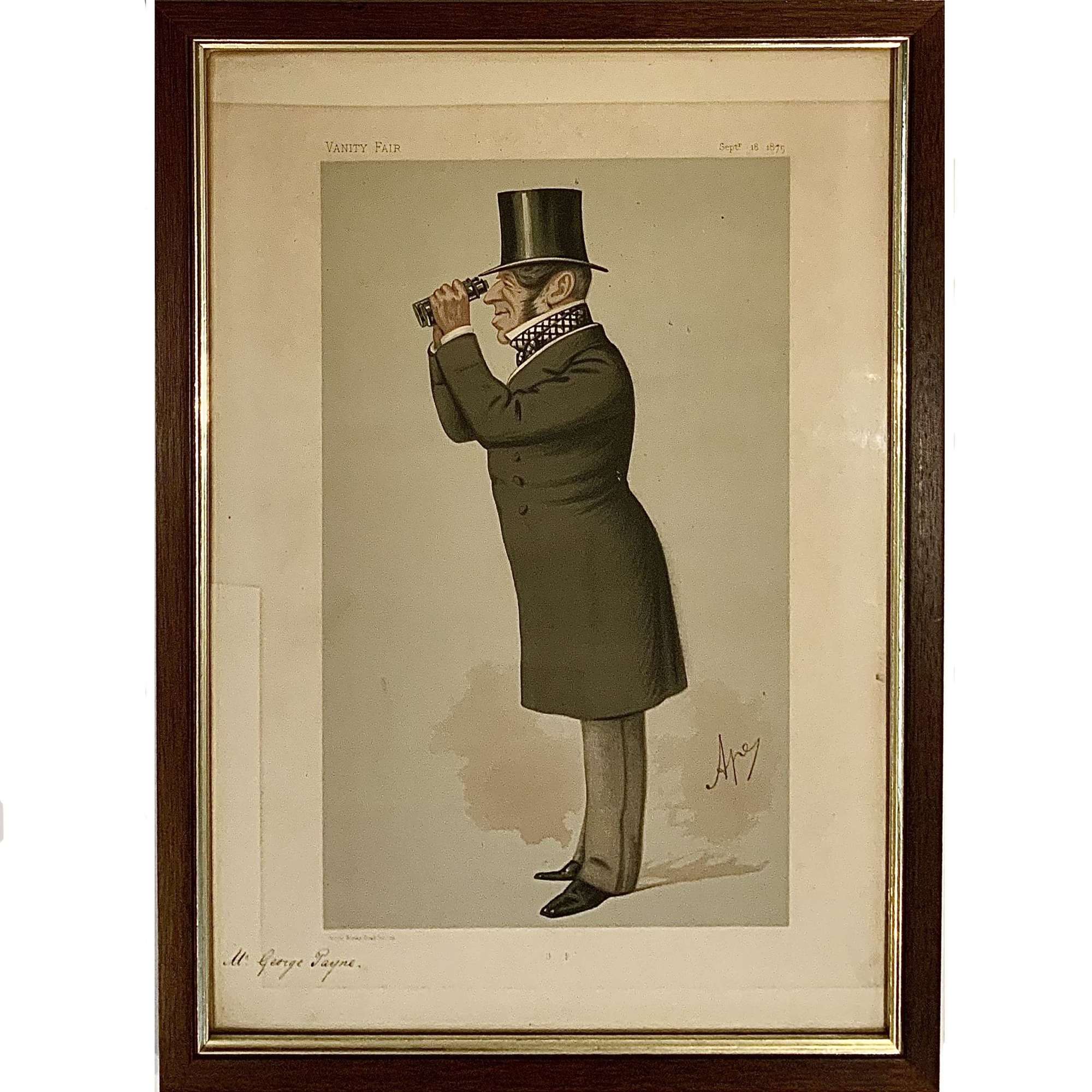

Vanity Fair Print “G.P.” turf patron George Payne (1803–1878) by ‘Ape’
Delivery Quote Request
Please fill in the form below to request a delivery quote from Tregeagle Fine Art.
Contact Tregeagle Fine Art
 Oxfordshire, United Kingdom
Oxfordshire, United Kingdom
Simply fill in the below form to get in touch with Tregeagle Fine Art regarding this item.
About this item
"G P" (George Payne (1804–1878))
By 'Ape' (Carlo Pellegrini (1839 –1889))
Original Chromolithograph
Printed on wove paper
Published in "Vanity Fair" by Vincent Brooks, Day & Son Ltd
London, 1875
Framed and glazed
Measures:-
44 cm x 31 cm (framed)
A portrait of George Payne (1803–1878) the colourful patron of the Turf, racehorse breeder, owner and inveterate gambler. Payne, depicted here looking through his binoculars (presumably at some distant horserace), was described by the great racing chronicler "Thormanby" as "a true English gentleman, large-hearted, high-spirited, the pink of chivalry and the soul of honour – a man of a most lovable nature".
When Payne was only six years old his father, George Payne of Sulby Hall, Northamptonshire, a wealthy partner in the banking enterprise Smith, Payne & Smiths of Lombard Street, died following a pistol duel with William Clark of Newcastle (1788-1869). The duel was fought in defence of the honour of Clarke's sister, to whom the married Payne had formed an attachment. At 5.30am on 6 September 1810 the two men stood twelve-paces apart at Caesar's Camp on Wimbledon Common. Payne had whispered to his second that he should not return Mr. Clark's fire. A single shot rang out and Payne fell to the ground, mortally wounded. The pistol ball had gone through his groin, he succumbed to the injury later that afternoon at the Red Lion Inn on Putney High Street. Clark never faced charges for Payne's death: he was a friend of Lord Byron and was due to travel with him to Greece in 1813 (but their trip was abandoned). He went on to become a doctor and served as Professor of Anatomy at Cambridge University. He also, remarkably, took holy orders, becoming Rector of Guiseley in West Yorkshire for the last 30 years of his life.
George Payne's final wish was for his son George to inherit the family seat at Sulby Hall, a trust fund of around £300,000 and an annual income of £17,000 from the Northamptonshire estates. The younger George was subsequently educated at Eton and Christ Church, Oxford (were he devoted himself to hunting and ribaldry and was asked to leave before graduating). An affection for horseracing was fostered by his uncle John Payne, who won the Derby in May 1817 with his 50-1 shot 'Azor'. Within a few years of his majority the younger George had frittered away his fortune. He is said to have lost £33,000 on a single bet on the 1824 St. Leger and when consoled by his friends to have replied "Oh! it's a pleasure to lose!" He bred the influential stud horse "Gladiator" and was the trainer of "Plenipotentiary", winner of the 1834 Derby.
Payne served as High Sheriff of Northamptonshire and Master of the Pytchley Hounds and ran through two further substantial legacies received from other relatives. In the end he had to relinquish Sulby Hall itself. The original Vanity Fair text (now absent) written when the print was published said:- "He has lost several fortunes, and won something; he has made many bets, and been the hero of many stories; and wherever a race is to be run, a game of skill and chance to be played, or a nice question to be decided, there is "G.P." looked up to as the best of all tribunals and the most popular of all men." His entry in the Dictionary of National Biography says that he "had hosts of friends and admirers, and no enemies". He died unmarried, a swathe of worthies attended his funeral, including the Prince of Wales (later King Edward VII).
Lettered beneath the image "G P" and with the publication details "VANITY FAIR" top left; "Septr 18 1875" top right; "Vincent Brooks, Day & Son Lt.d Lith." lower left. Signed with Carlo Pellegrini's "Ape" signature (within the image). Annotated in a very neat copperplate manuscript hand with the identity of the subject lower left.
Originally appeared as "Vanity Fair " 'Men of the Day. No. No. CIX" [109] on September 18 1875
Additional Information
10869 (AB-122658)
W: 31cm (12.2")H: 44cm (17.3")
Victorian (1837 to 1901)
![]() Oxfordshire, United Kingdom
Oxfordshire, United Kingdom










